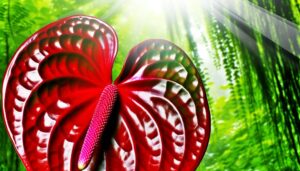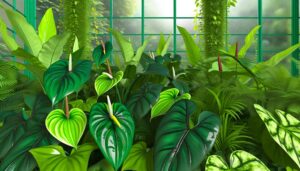10 Key Differences Between Anthurium Clarinervium Vs Crystallinum
Anthurium clarinervium and Anthurium crystallinum exhibit distinct differences. A.
clarinervium has heart-shaped leaves with thick, symmetrical veins and a velvety texture, whereas A. crystallinum features oval leaves with finer veins and a satin-like surface.
Clarinervium shows high contrast white veins on darker green leaves, while crystallinum has a lighter, metallic sheen with delicate white markings. Clarinervium is compact (30-50 cm), while crystallinum grows taller (60-90 cm).
Their root structures and flowering also differ. A.
clarinervium has thicker roots and heart-shaped spathes, while crystallinum has finer roots and lanceolate spathes. Curious about more nuances in care and development?
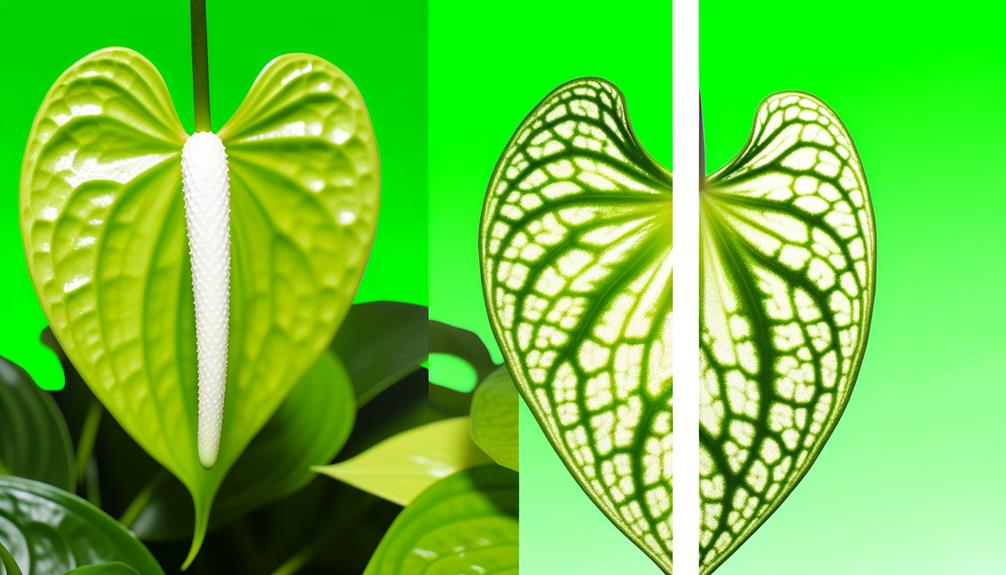
10 Key Differences Between Anthurium Clarinervium and Anthurium Crystallinum:
| Feature | Anthurium Clarinervium | Anthurium Crystallinum |
|---|---|---|
| Leaf Shape | Heart-shaped with a velvety texture | Heart-shaped with a slightly stiffer texture |
| Leaf Size | Generally larger, can grow up to 25 cm in length | Smaller compared to Clarinervium, usually under 20 cm |
| Vein Color | White to light green, very prominent | Silver to white, also very prominent |
| Leaf Surface | Velvety and thick | Glossier and less velvety than Clarinervium |
| Petiole (Stem) | Thicker and shorter | Longer and slender |
| Growth Habit | More compact and bushier | Tends to be more sprawling |
| Flower Spathe | Rarely flowers indoors; spathe is green when it does | Rarely flowers indoors; spathe is lighter green |
| Optimal Humidity | Prefers higher humidity, around 70-80% | Slightly lower humidity tolerance, around 60-70% |
| Root System | Robust and requires more frequent repotting | Less aggressive, slower growing root system |
| Preferred Light | Bright, indirect light but can tolerate lower light | Prefers more consistent bright, indirect light |
Key Takeaways
- Anthurium clarinervium has heart-shaped leaves, while Anthurium crystallinum leaves are oval to elliptical.
- A. clarinervium features thicker, symmetrical veins; A. crystallinum has finer, less uniform veins.
- A. clarinervium leaves are darker green with a velvety texture; A. crystallinum leaves are lighter green and smoother.
- A. clarinervium grows more compact (30-50 cm); A. crystallinum is more expansive (60-90 cm).
- A. clarinervium adapts better to lower humidity; A. crystallinum is more sensitive to humidity changes.
Leaf Shape
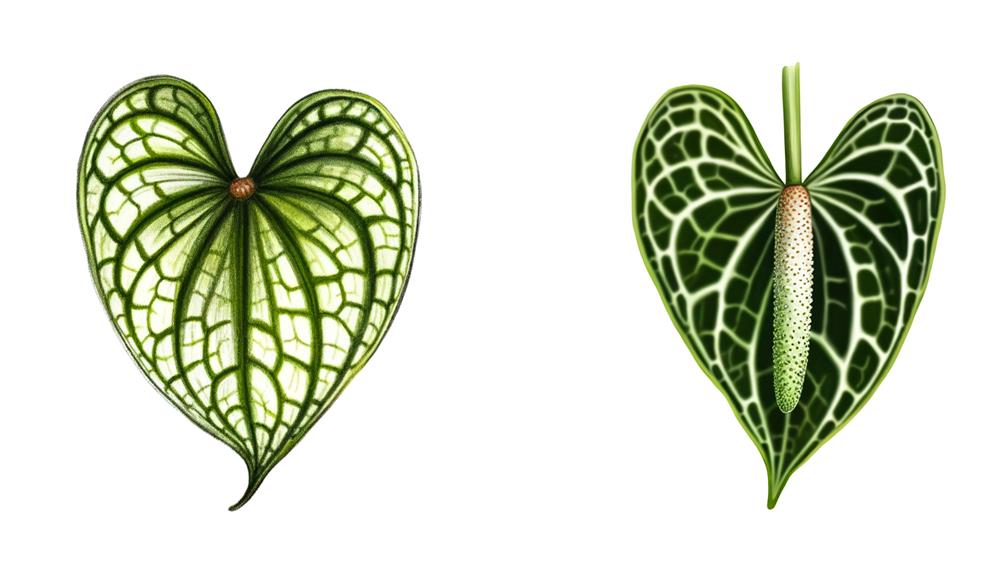
The leaf shape of Anthurium clarinervium is typically heart-shaped with prominent lobes at the base, whereas Anthurium crystallinum exhibits an oval to elliptical shape with more elongated and less pronounced basal lobes.
The heart-shaped morphology of A. clarinervium displays a broader, almost cordate form, with a notable indentation at the petiole junction.
In contrast, A. crystallinum’s leaves are more streamlined, presenting a less acute sinus at the base and a more elongated overall profile.
Empirical observations indicate that the mean leaf length-to-width ratio for A. clarinervium is approximately 1.25:1, whereas A. crystallinum demonstrates a ratio closer to 1.5:1.
These morphological distinctions are critical for accurate species identification and understanding their adaptive strategies in diverse ecological niches.
Vein Pattern
The vein patterns of Anthurium clarinervium and Anthurium crystallinum exhibit distinct morphological differences, primarily characterized by their prominent white markings.
Empirical observations indicate that the veins of A. clarinervium are generally thicker and more pronounced than those of A. crystallinum.
Additionally, A. clarinervium displays a more symmetrical vein arrangement, while A. crystallinum’s vein pattern tends to be less uniform and more intricate.
Distinctive White Markings
Characterized by intricate vein patterns, Anthurium clarinervium exhibits prominent, white veins that contrast sharply against its dark green leaves, while Anthurium crystallinum’s veins, although similarly striking, tend to be finer and less pronounced.
The distinctiveness of Anthurium clarinervium’s venation is due to the high contrast between the white veins and the leaf’s chlorophyll-rich tissue, creating a visually arresting pattern.
In comparison, Anthurium crystallinum features a more subtle veining, often described as delicate, with white markings that integrate more seamlessly with the surrounding leaf surface.
Empirical observations indicate that these vein patterns are not merely aesthetic but play an essential role in the physiological processes, such as nutrient transport and structural support, of these species.
Vein Thickness Comparison
Significantly, Anthurium clarinervium boasts thicker and more pronounced vein patterns compared to the finer, more delicate veins of Anthurium crystallinum.
The veins of A. clarinervium are robust and prominent, typically exhibiting a thickness averaging 3-4 mm. This pronounced venation is highly visible against the dark, velvety leaf surface, providing a striking contrast.
In contrast, A. crystallinum features veins that are considerably finer, measuring approximately 1-2 mm in thickness.
These veins are intricately woven, forming a more intricate and delicate network. The subtler venation of A. crystallinum contributes to its more refined aesthetic.
Empirical observations suggest that the vein thickness in these species plays a significant role in their structural support and nutrient transport mechanisms.
Pattern Symmetry Differences
In addition to differences in vein thickness, Anthurium clarinervium and Anthurium crystallinum exhibit distinct variations in the symmetry of their vein patterns.
Anthurium clarinervium features a more centralized, symmetrical venation with veins radiating uniformly from the midrib, creating a balanced and orderly appearance.
Empirical observations indicate that this species’ vein symmetry contributes to its aesthetically pleasing geometric pattern.
Conversely, Anthurium crystallinum displays a less symmetrical vein arrangement, characterized by veins that branch out more irregularly from the central vein. This lack of uniformity in vein distribution results in a more intricate and complex leaf pattern.
These variations in vein symmetry not only influence the visual appeal but also suggest potential differences in leaf physiology and function between the two species.
Leaf Texture

The leaf texture of Anthurium Clarinervium is particularly velvety, giving it a soft, almost plush feel, whereas Anthurium Crystallinum exhibits a smoother, more satin-like surface. This distinction arises from the differential distribution of epidermal cells and trichomes on their leaves.
Anthurium Clarinervium’s leaves possess a higher density of trichomes, contributing to their velvety texture. In contrast, Anthurium Crystallinum’s leaves have fewer trichomes, resulting in a glossier, satin appearance.
Empirical observations indicate that the tactile sensations are markedly different, with Clarinervium presenting a textured, almost fuzzy touch, while Crystallinum offers a slicker, more polished feel.
These textural differences are vital for horticulturists and enthusiasts aiming to identify and differentiate between these two Anthurium species accurately.
Leaf Color
Leaf color in Anthurium Clarinervium and Anthurium Crystallinum exhibits distinct characteristics, particularly in their vivid green shades and vein color contrast.
Empirical observations indicate that Clarinervium leaves maintain a darker, more saturated green, whereas Crystallinum leaves often present a lighter, more translucent green.
Additionally, the aging process of leaves in both species reveals differential color changes, with Clarinervium tending to retain its coloration longer compared to Crystallinum.
Vivid Green Shades
Exhibiting a striking spectrum of green hues, Anthurium clarinervium leaves typically display a darker, velvety green compared to the slightly lighter, more metallic sheen of Anthurium crystallinum foliage.
The chlorophyll concentration in A. clarinervium is markedly higher, contributing to its intense, deep green coloration, often resembling the richness of emerald.
Conversely, A. crystallinum’s foliage, while still vibrant, tends toward a more luminescent green, reflecting light more readily due to its smoother, glossier surface.
Empirical observations indicate that under identical light conditions, A. crystallinum’s leaves exhibit a higher degree of reflectance, enhancing their metallic appearance.
These subtle yet distinct variations in leaf pigmentation provide essential diagnostic criteria for botanists and horticulturists in identifying and differentiating between these two species.
Vein Color Contrast
Distinctive vein color patterns further differentiate Anthurium clarinervium from Anthurium crystallinum. Anthurium clarinervium displays prominent white or silver veins against its dark green background.
In contrast, Anthurium crystallinum features less contrasted, yet still noticeable, white veins on its lighter, more metallic leaves.
The stark contrast in Anthurium clarinervium is attributable to the high concentration of anthocyanins in the veins. This enhances visibility against the chlorophyll-rich lamina.
Conversely, Anthurium crystallinum exhibits a subtler vein pattern due to a balanced distribution of pigments, creating a more uniform appearance.
Empirical observations indicate that the vein structure in clarinervium is more robust, aiding in its identification. Hence, vein color contrast serves as a critical morphological marker in distinguishing these two Anthurium species.
Leaf Aging Process
The senescence process in Anthurium leaves reveals distinct color transformations that serve as key indicators for species identification.
In Anthurium clarinervium, aging leaves often shift from deep green to a yellowish hue before ultimately turning brown.
By contrast, Anthurium crystallinum exhibits a more gradual color change wherein leaves transition from dark green to a lighter green, eventually progressing to a pale yellow.
Key differences include:
- Color Shift Speed: Clarinervium leaves change color more rapidly compared to the more gradual shift in crystallinum.
- Intermediate Colors: Clarinervium displays a noticeable yellow phase, whereas crystallinum’s intermediate green stage is more extended.
- Final Color: Both species end in a brown leaf, but the path to this endpoint varies significantly in shade intensity and duration.
Growth Habit

Anthurium clarinervium exhibits a more compact growth habit with thicker leaves, while Anthurium crystallinum tends to have a more expansive growth with thinner, larger leaves.
The former typically reaches a height of approximately 30-50 cm, characterized by a dense rosette formation. This compactness is due to its shorter internodes and robust petioles.
In contrast, Anthurium crystallinum can attain a height of up to 60-90 cm and showcases a more open and spreading form. The elongated internodes and more delicate petioles contribute to its broader spatial occupation.
Empirical observations indicate that Anthurium crystallinum’s larger leaf surface area facilitates higher photosynthetic efficiency, thereby supporting its more vigorous growth. Understanding these distinctions aids in optimizing cultivation practices tailored to each species’ specific needs.
Root Structure
The root structure of Anthurium clarinervium and Anthurium crystallinum exhibits distinct differences in root growth patterns and root system size.
Anthurium clarinervium typically develops a more compact root system with shorter, thicker roots, whereas Anthurium crystallinum forms an extensive root network characterized by longer, finer roots.
These variations in root morphology have significant implications for their respective nutrient acquisition and substrate preferences.
Root Growth Patterns
Root growth patterns in Anthurium clarinervium and Anthurium crystallinum exhibit distinct differences, particularly in the density and distribution of root hairs.
Empirical observations indicate that Anthurium clarinervium manifests a more uniform root hair distribution, optimizing nutrient absorption in a variety of soil compositions.
Conversely, Anthurium crystallinum demonstrates a higher density of root hairs localized primarily on the younger roots.
These differences can be summarized as follows:
- Root Hair Density: Higher in A. crystallinum, particularly on younger roots.
- Distribution Uniformity: More uniform in A. clarinervium, enhancing adaptability to different substrates.
- Nutrient Absorption Efficiency: A. clarinervium exhibits broader adaptability, while A. crystallinum shows specialization.
These root growth characteristics are pivotal in understanding the ecological adaptations and care requirements of each species.
Root System Size
Distinct differences in root system size between Anthurium clarinervium and Anthurium crystallinum greatly impact their growth and soil anchorage mechanisms.
Anthurium clarinervium typically exhibits a more compact root system, characterized by shorter, thicker roots that allow efficient nutrient uptake in confined spaces.
In contrast, Anthurium crystallinum develops an extensive root network with longer, finer roots that enhance its ability to explore larger soil volumes for water and nutrients.
Empirical data indicate that A. crystallinum’s root systems can extend up to 30% further in substrate depth compared to A. clarinervium.
This distinct disparity in root structure not only facilitates varied growth patterns but also necessitates different potting and soil conditions to optimize their developmental processes.
Flowering
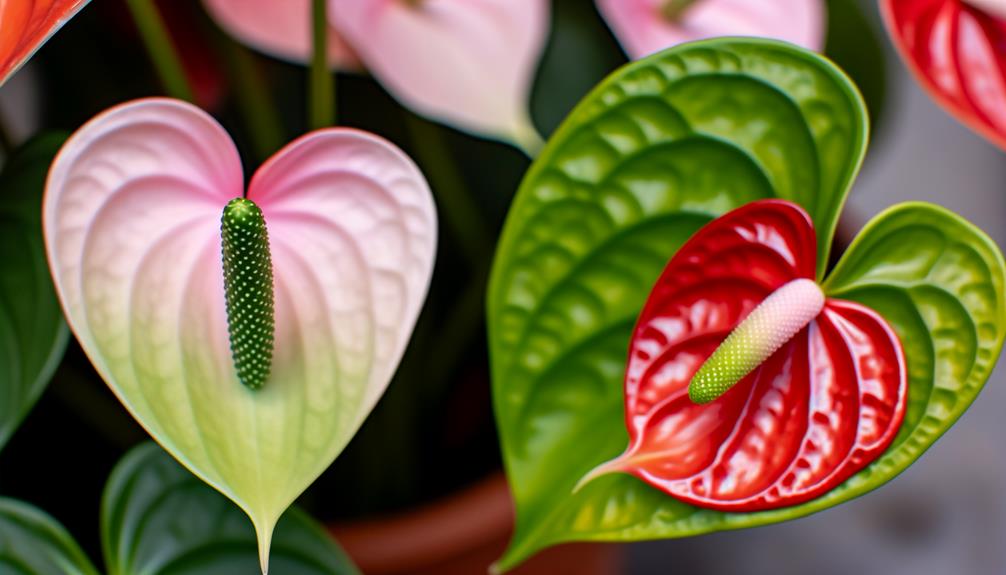
Flowering in Anthurium clarinervium and Anthurium crystallinum exhibits notable differences in inflorescence structure and blooming cycles.
Anthurium clarinervium typically produces smaller inflorescences, with a compact spadix and a heart-shaped spathe.
In contrast, Anthurium crystallinum showcases larger, more elongated inflorescences, characterized by an extended spadix and a lanceolate spathe.
Key distinctions include:
- Inflorescence Size: Anthurium crystallinum’s inflorescences are generally larger and more prominent.
- Spathe Shape: Clarinervium features a heart-shaped spathe, whereas crystallinum has a lanceolate spathe.
- Blooming Frequency: Anthurium crystallinum tends to bloom more frequently throughout the year compared to Anthurium clarinervium.
These morphological and phenological differences are critical for horticulturists aiming to cultivate these species effectively.
Light Requirements
Adequate light is essential for the best growth of both Anthurium clarinervium and Anthurium crystallinum, with both species thriving most under bright, indirect light conditions.
Direct sunlight can cause foliar burns, leading to chlorosis and necrosis, negatively impacting the plant’s aesthetic and physiological health.
Empirical data suggests that both species perform best when exposed to 1000-2000 foot-candles (fc) of light.
Insufficient light can result in etiolation, characterized by elongated stems and pale leaves, detracting from their unique venation patterns.
Artificial grow lights, particularly those emitting full-spectrum light, can supplement natural light to maintain consistent photoperiods, promoting strong foliage and overall plant vigor.
Understanding these light requirements is vital for cultivating healthy, visually appealing Anthuriums.
Watering Needs
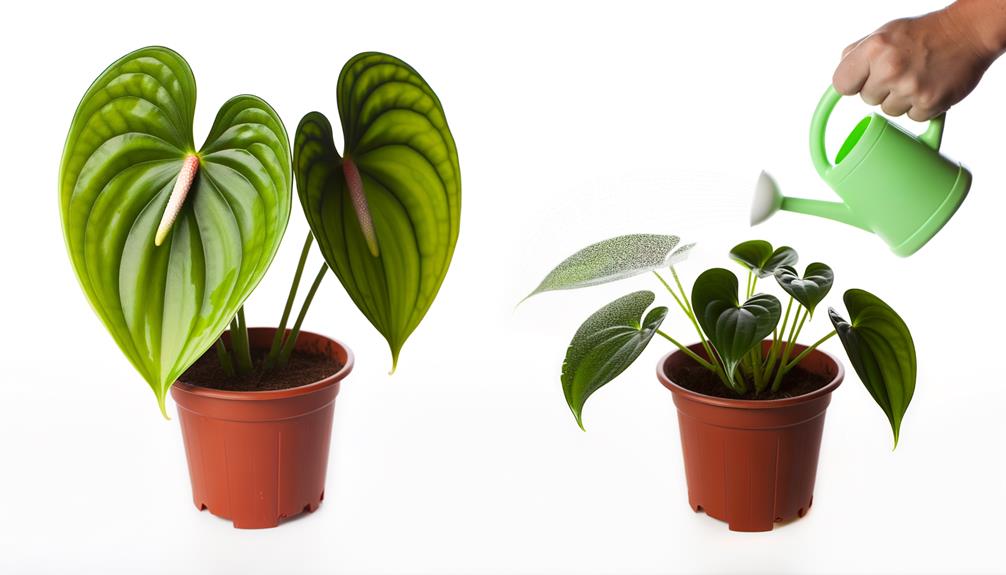
While light requirements are vital for Anthurium clarinervium and Anthurium crystallinum, understanding their specific watering needs is equally essential for ensuring ideal growth and health.
Both species thrive in well-draining soil to prevent root rot, yet their watering schedules differ slightly due to their native habitats.
- Anthurium clarinervium requires moderate watering, allowing the top 1-2 inches of soil to dry between waterings.
- Anthurium crystallinum prefers consistently moist soil but should not be waterlogged, necessitating a more frequent but lighter watering approach.
- Both species benefit from distilled or rainwater, as tap water may contain minerals harmful to their growth.
Empirical data suggests overwatering remains the primary cause of morbidity in these species, underscoring the importance of tailored hydration strategies.
Humidity Preferences
Humidity levels significantly impact the growth and health of Anthurium clarinervium and Anthurium crystallinum, with both species requiring consistently high humidity to thrive at their best.
Empirical studies suggest that the best relative humidity for these species ranges between 60% and 80%.
Anthurium clarinervium shows exceptional adaptability to slightly lower humidity levels, while Anthurium crystallinum shows a more noticeable sensitivity, often exhibiting signs of stress such as leaf browning and reduced growth under less than ideal conditions.
Maintaining these humidity levels can be achieved through humidifiers, pebble trays, or regular misting.
Monitoring ambient humidity with hygrometers is advisable to ensure steady conditions. Understanding these preferences is essential for cultivating healthy, vibrant specimens of both species.
Conclusion
In summation, the distinctions between Anthurium clarinervium and Anthurium crystallinum are as clear as night and day, encompassing leaf structure, veining, texture, color, growth patterns, reproductive structures, light requirements, hydration, and atmospheric moisture preferences.
These differences underscore the unique ecological niches and cultivation needs of each species.
Understanding these disparities is crucial for horticulturists and botanists alike, as it informs both conservation efforts and best care practices for maintaining these botanical treasures.



